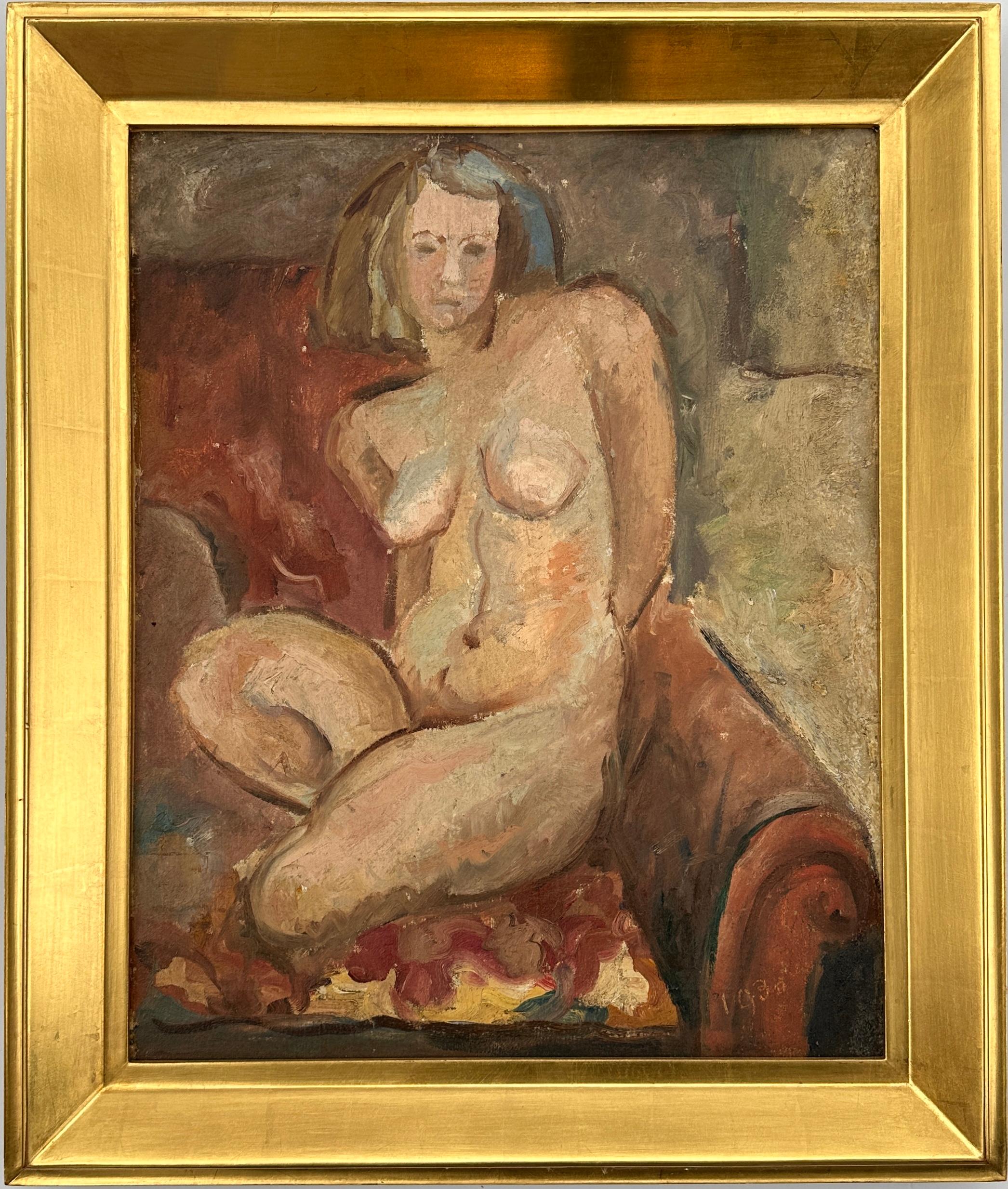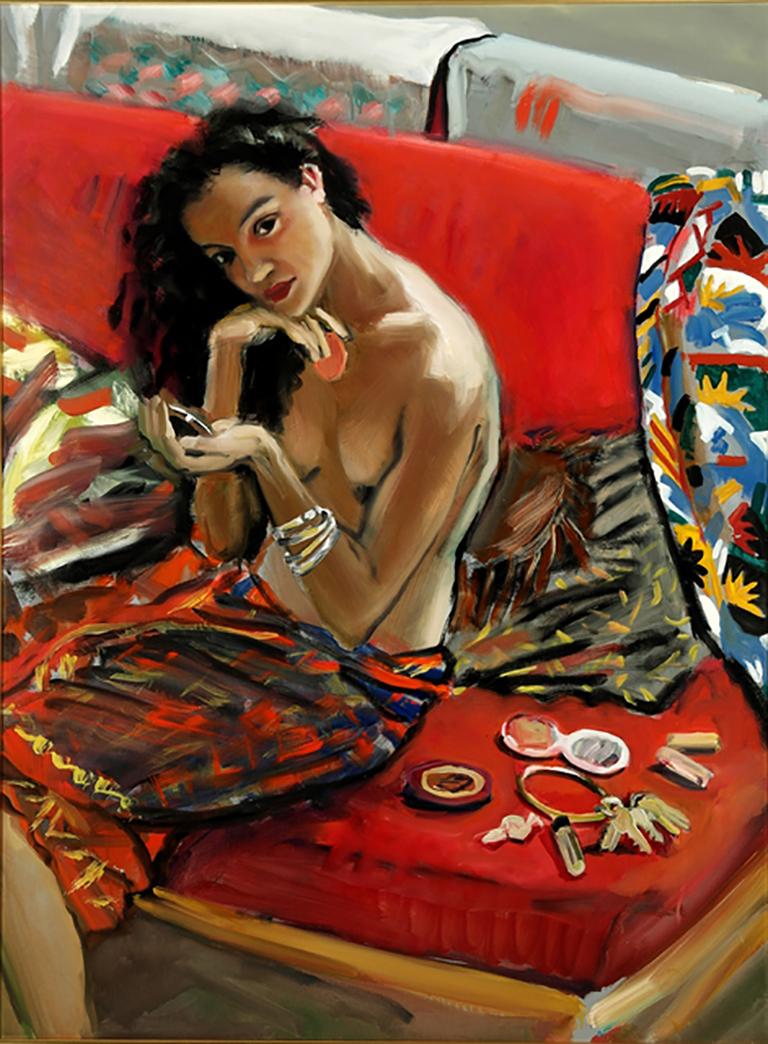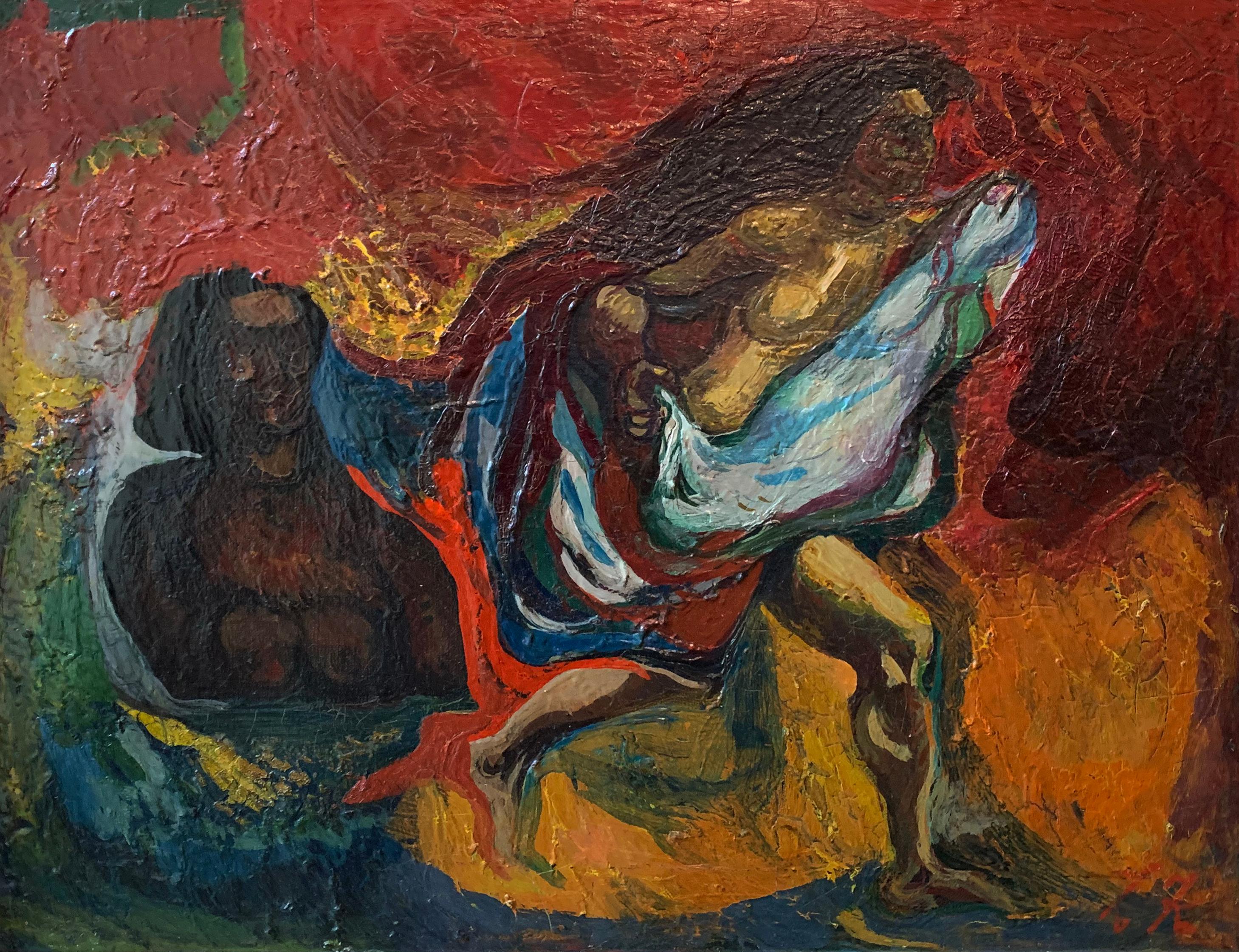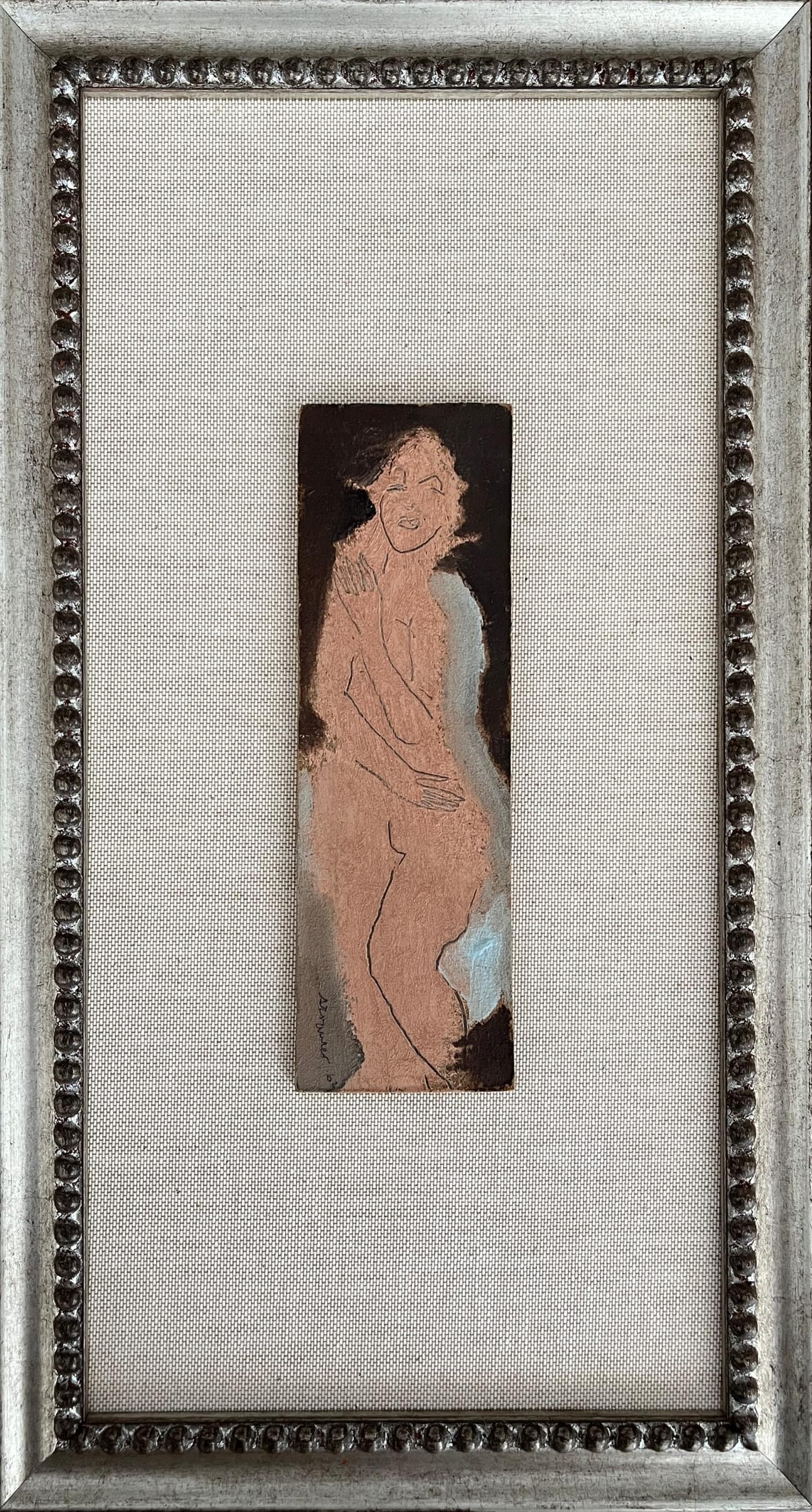Items Similar to Nude with Drape
Want more images or videos?
Request additional images or videos from the seller
1 of 5
Fletcher MartinNude with Drape
About the Item
Nude with Drape, c. 1937, oil on board, 24 x 17 (oval), signed lower right, provenance: Frances Lee Kent Falcone Family Trust
About the Painting
Fletcher Martin’s Nude with Drape is a very modern take on one of the oldest subjects in western art, the female nude. In this work, we see the structural influence of Cezanne, the artist who meant the most to Martin, the impact of Surrealism, and the classical ordering of De Chirico. When discussing American Surrealism in his essay American Art Today for the catalog of the art exhibition at the 1939 New York World’s Fair, Holger Cahill noted, “The surrealists cultivate the fantastic, the mysterious and even the macabre, and their work has been colored to a considerable extent by the ideas of the psychoanalysts. While they stress spontaneous and untrammeled personal expression to the point of irrationality, they have shown a great deal of aptitude for technical discipline. They have a way of painting the most bizarre subject matter in the driest and most deliberate academic technique. Straight surrealism, as practiced by the European adept, has not proved attractive to many American artists . . . . however, a good many of the works exhibited indicated that surrealist ideas and technique have been assimilated into the stream of contemporary American expression.” The assimilation and technical virtuosity described by Cahill is what we find in Nude with Drape.
About the Artist
Fletcher Martin was a well-respected artist, illustrator and teacher who worked in a variety of media. Born in Colorado, Martin was largely self-taught. He initially served in the Navy before moving to Los Angeles where he was represented by the Hatfield Gallery and had his first solo museum show at the San Diego Fine Arts Gallery in 1934. Martin and his work are associated with some of the most prominent artists of the 20th century.He was an assistant to Siquieros and followed both Grant Wood and Thomas Hart Benton in their teaching assignments at the University of Iowa and the Kansas City Art Institute, respectively. Martin spent decades teaching at other institutions, including the Art Students League in New York and Mills and Claremont Colleges, both in California. Martin exhibited extensively during the 1930s and 1940s at every major institution in the US, including the Museum of Modern Art (New York), the Los Angeles County Museum of Art and the Whitney Museum of American Art. His paintings received numerous awards and strong critical response.He completed several WPA and Federal Art Project Commissions, including a fresco for Hollywood High School and a mural for the Federal Building in San Pedro, California. Martin’s works are in the collections of over two dozen museums, including the Metropolitan Museum of Art (New York), the Museum of Modern Art (New York), the Whitney and LACMA.He is extensively listed in Who was Who in American Art and all other standard references.
- Creator:Fletcher Martin (1904-1979, American)
- Dimensions:Height: 17 in (43.18 cm)Width: 24 in (60.96 cm)Depth: 1 in (2.54 cm)
- More Editions & Sizes:26.5 x 33.2 x 2 inches (framed)Price: $20,000
- Medium:
- Movement & Style:
- Period:
- Condition:
- Gallery Location:Los Angeles, CA
- Reference Number:1stDibs: LU1859210062642
About the Seller
No Reviews Yet
Vetted Seller
These experienced sellers undergo a comprehensive evaluation by our team of in-house experts.
1stDibs seller since 2022
6 sales on 1stDibs
Typical response time: 8 hours
- ShippingRetrieving quote...Ships From: Los Angeles, CA
- Return PolicyA return for this item may be initiated within 3 days of delivery.
More From This SellerView All
- Six O'ClockLocated in Los Angeles, CASix O-Clock, c. 1942, oil on canvas, 30 x 20 inches, signed and titled several times verso of frame and stretcher (perhaps by another hand), marked “Rehn” several times on frame (for the Frank K. M. Rehn Galleries in New York City, who represented Craig at the time); Exhibited: 1) 18th Biennial Exhibition of Contemporary American Oil Paintings from March 21 to May 2, 1943 at The Corcoran Gallery of Art in Washington, D.C. #87, original price $450 (per catalog) (exhibition label verso), 2) Craig’s one-man show at the Frank K. M. Rehn Galleries, New York City, from October 26 to November 14, 1942, #10 (original price listed as $350); and 3) Exhibition of thirty paintings sponsored by the Harrisburg Art Association at the State Museum of Pennsylvania in Harrisburg in March, 1944 (concerning this exhibit, Penelope Redd of The Evening News (Harrisburg, Pennsylvania) wrote: “Other paintings that have overtones of superrealism inherent in the subjects include Tom Craig’s California nocturne, ‘Six O’Clock,’ two figures moving through the twilight . . . .” March 6, 1944, p. 13); another label verso from The Museum of Art of Toledo (Ohio): original frame: Provenance includes George Stern Gallery, Los Angeles, CA About the Painting Long before Chris Burden’s iconic installation outside of the Los Angeles County Museum of Art, Urban Light, another artist, Tom Craig, made Southern California streetlights the subject of one of his early 1940s paintings. Consisting of dozens of recycled streetlights from the 1920s and 1930s forming a classical colonnade at the museum’s entrance, Burden’s Urban Light has become a symbol of Los Angeles. For Burden, the streetlights represent what constitutes an advanced society, something “safe after dark and beautiful to behold.” It seems that Craig is playing on the same theme in Six O-Clock. Although we see two hunched figures trudging along the sidewalk at the end of a long day, the real stars of this painting are the streetlights which brighten the twilight and silhouette another iconic symbol of Los Angeles, the palm trees in the distance. Mountains in the background and the distant view of a suburban neighborhood join the streetlights and palm trees as classic subject matter for a California Scene painting, but Craig gives us a twist by depicting the scene not as a sun-drenched natural expanse. Rather, Craig uses thin layers of oil paint, mimicking the watercolor technique for which he is most famous, to show us the twinkling beauty of manmade light and the safety it affords. Although Southern California is a land of natural wonders, the interventions of humanity are already everywhere in Los Angeles and as one critic noted, the resulting painting has an air of “superrealism.” About the Artist Thomas Theodore Craig was a well-known fixture in the Southern California art scene. He was born in Upland California. Craig graduated with a degree in botany from Pomona College and studied painting at Pamona and the Chouinard Art School with Stanton MacDonald-Wright and Barse Miller among others. He became close friends with fellow artist Milford Zornes...Category
1940s American Modern Landscape Paintings
MaterialsCanvas, Oil
- Subway ConstructionLocated in Los Angeles, CAThis painting is part of our exhibition American Coast to Coast: Artists of the 1930s Subway Construction, c. 1928, oil on board, 19 x 15 ¾ inches, signed upper left, artist and title verso; exhibited: 1) 12th Annual Exhibition of the Society of Independent Artists, The Waldorf Astoria, New York NY, from March 9 to April 1, 1928, no. 864 (original price $250) (see Death Prevailing Theme of Artists in Weird Exhibits, The Gazette (Montreal, Quebec, Canada), March 8, 1928); 2) Boston Tercentenary Exhibition Fine Arts and Crafts Exhibition, Horticultural Hall, Boston MA, July, 1930, no. 108 (honorable mention - noted verso); 3) 38th Annual Exhibition of American Art, Cincinnati Art Museum, Cincinnati, OH, June, 1931 (see Alexander, Mary, The Week in Art Circles, The Cincinnati Enquirer, June 7, 1931); and 4) National Art Week Exhibition [Group Show], Montross Gallery, New York, New York, December, 1940 (see Devree, Howard, Brief Comment on Some Recently Opened Exhibitions in the Galleries, The New York Times, December 1, 1940) About the Painting Ernest Stock’s Subway Construction depicts the excavation of New York’s 8th Avenue line, which was the first completed section of the city-operated Independent Subway System (IND). The groundbreaking ceremony was in 1925, but the line did not open until 1932, placing Stock’s painting in the middle of the construction effort. The 8th Avenue line was primarily constructed using the “cut and cover” method in which the streets above the line were dug up, infrastructure was built from the surface level down, the resulting holes were filled, and the streets reconstructed. While many artists of the 1920s were fascinated with the upward thrust of New York’s exploding skyline as architects and developers sought to erect ever higher buildings, Stock turned his attention to the engineering marvels which were taking place below ground. In Subway Construction, Stock depicts workers removing the earth beneath the street and building scaffolding and other support structures to allow concrete to be poured. Light and shadow fall across the x-shaped grid pattern formed by the wooden beams and planks. It is no surprise that critics reviewing the painting commented on Stock’s use of an “interesting pattern” to form a painting that is “clever and well designed.” About the Artist Ernest Richard Stock was an award-winning painter, print maker, muralist, and commercial artist. He was born in Bristol, England and was educated at the prestigious Bristol Grammar School. During World War I, Stock joined the British Royal Air Flying Corps in Canada and served in France as a pilot where he was wounded. After the war, he immigrated to the United States and joined the firm of Mack, Jenny, and Tyler, where he further honed his architectural and decorative painting skills. During the 1920s, Stock often traveled back and forth between the US and Europe. He was twice married, including to the American author, Katherine Anne Porter. Starting in the mid-1920s, Stock began to exhibit his artwork professionally, including at London’s Beaux Arts Gallery, the Society of Independent Artists, the Salons of America, the Cincinnati Art Museum, the Whitney Studio and various locations in the Northeast. Critics often praised the strong design sensibility in Stock’s paintings. Stock was a commercial illustrator for a handful of published books and during World War II, he worked in the Stratford Connecticut...Category
1920s American Modern Figurative Paintings
MaterialsOil
- Untitled (Elevated Platform)Located in Los Angeles, CAThis painting is part of our current exhibition - America Coast to Coast: Artists of the 1940s Untitled (Elevated Platform), 1950, oil on canvas, signed and dated lower right, 30 x...Category
1950s American Modern Paintings
MaterialsCanvas, Oil
- Riders of Pigeon HillBy Jon CorbinoLocated in Los Angeles, CARiders of Pigeon Hill, c. 1940s, oil on canvas, signed lower right, 24 x 36 inches, label verso with title, artist’s name and address; same information inscribed verso; ex-collection...Category
1940s American Modern Paintings
MaterialsCanvas, Oil
- Gold Mine, Central City, ColoradoBy Joseph MeertLocated in Los Angeles, CAThis painting is part of our exhibition America Coast to Coast: Artists of the 1930s Goldmine, Central City, Colorado, oil on canvas, 36 x 28 inches, c. 1936, signed lower right, ex collection of Platt Fine Art, Chicago, Illinois (label verso). About the Painting Joseph Meert’s painting, Goldmine, Central City, Colorado, depicts the short-lived resurrection of a once prominent city just outside Denver. Central City was founded in 1859 soon after John Gregory struck gold in the area. As word spread, thousands of miners converged into “Gregory’s Gulch” and its surroundings became known as the “richest square mile on earth.” Mining production quickly increased resulting in Central City to becoming Colorado’s largest city in the early 1860s. Despite some technical difficulties transitioning to lode mining and the rise of competition from Leadville, Central City remained an economic boom town through the turn of the century. But, with every boom, there is a bust. World War I marked the end of Central City’s prominence as ore production ground to a halt and by 1925, the town’s population shrank to only 400 people. The desperation of the Great Depression and a nearly 100% increase in the price of gold lured labor and capital back to Central City. Meert painted in Colorado during the mid-1930s, a time when he created his most desirable works. It is during this period of renaissance that Meert captures one of Central City's outlying dirt streets bordered by 19th century wooden houses from the town's heyday and the more recently installed electric lines leading to a distant gold mine. A lone figure trudges up the hill, a mother with a baby in her arms, putting us in mind of the rebirth of the town itself. Meert had solo exhibitions at the Colorado Springs Fine Arts Center in 1936 and the Denver Art Museum. Although it is not known whether Goldmine, Central City was included in either of these exhibitions, it seems likely. Moreover, the painting is closely related to Meert’s painting, The Old Road, which was painted in 1936 and exhibited at the Corcoran Gallery of Art in Washington, DC and at the Dallas Museum of Art. About the Artist Joseph Meert was a well-regarded painter and muralist, who initially made a name for himself in the American Scene and later as an abstract expressionist. Although initially successful, Meert struggled financially and with mental illness later in life. He was born in Brussels, Belgium, but moved with his family to Kansas City, Missouri. As a child, a chance encounter at the Union Pacific Railyard changed his life. Meert happened upon a worker repainting and stenciling a design on a railroad car. Meert later recalled that this experience introduced him to the idea of being a painter. Without support from his father, Meert obtained a working scholarship to the Kansas City Art Institute. After four years at the Kansas City Art Institute, Meert studied seven years at the Art Students League and in Europe and Los Angeles. At the Art Students League, Meert fell under the spell of Thomas Hart Benton and Stanton MacDonald-Wright. In 1931, he befriended Jackson Pollock. By 1934, Meert was part of the Public Works of Art Project when he met his wife, Margaret Mullin...Category
1930s American Modern Landscape Paintings
MaterialsOil, Canvas
- Untitled (Transcendental Composition)By Charles Ragland BunnellLocated in Los Angeles, CAThis work is part of our exhibition - America Coast to Coast: Artists of the 1940s Untitled (Transcendental Composition), oil on board, 1947, oil on board, signed and dated lower r...Category
1940s American Modern Paintings
MaterialsOil, Board
You May Also Like
- The Artist's Wife oil painting by Hans BurkhardtBy Hans BurkhardtLocated in Hudson, NYHans Burkhardt The Artist's Wife (1930) Oil on canvas, 20" x 16" 24" x 20 ½" x 1 ½" framed Dated 1930 lower right recto. Annotated "To Elsa HB Louise Burkhardt 1930. HB" verso. ...Category
1930s American Modern Nude Paintings
MaterialsOil, Canvas
- "Nude Musicians" WPA Mid 20th Century American Modernism LGBT Social Realism GayLocated in New York, NYCarl Gustaf Simon Nelson, American (1898-1988) "Nude Musicians," 30 x 35 inches, oil on canvas Signed and dated 1938 signature lower right. Provenance: Collection of Seymour Stein Bio Carl Gustaf Simon Nelson (1898 - 1988) A painter, graphic artist and teacher whose paintingfocus was color and content landscapes, Nelson at age five immigrated with his family to Sioux City, Iowa from Sweden in 1903. He studied at the Chicago Academy of Fine Arts* from 1920 to 1921, then at the Art Students League* in New York from 1923 to 1927 with Kimon Nicolaides and Kenneth Hayes Miller. He taught at the American Peoples School of New York, an adult education project; at the Cambridge School of Design from 1948 to 1952; and finally at the Boston YMCA until 1968. His work was exhibited at the Carnegie...Category
1930s American Modern Figurative Paintings
MaterialsCanvas, Oil
- BathersBy William GropperLocated in West Hollywood, CAWe are proud to present outstanding original oil on canvas by American artist William Gropper (1897-1977.) William Gropper was an artist and illustrator, known for his exceptional a...Category
1940s American Modern Figurative Paintings
MaterialsOil
- Queen of the Night, narrative, partial nude figure, red colors, ethnic fabricsBy Audrey AnastasiLocated in Brooklyn, NYABOUT the artist: Audrey Frank Anastasi is a prolific feminist artist, working in painting, drawing, collage, mixed media, & printmaking. She is also curator, gallerist, educator and arts advocate. Most of Ms. Anastasi's figurative works are painted with her non-dominant left hand. She has created large bodies of works of birds, animals and birch trees. She has had 20 solo & 200 group shows. Her "ref-u-gee" series will be shown in 2020 at Medgar Evers College in collaboration with the Valentine Museum of Art, Brooklyn. Accompanying the show will be a limited-edition monograph w/ over 180 images and a foreword by Phyllis Braff. Ms. Anastasi's collage series was exhibited at Welancora Gallery, Brooklyn, in May, 2019. In 2018, ten paintings were exhibited in "Painting to Survive," curated by Yale critic Jonathan Weinberg. Book and catalog publications include "Stations of the Cross", SPQR press, BREUCKELEN magazine, “Audrey Frank Anastasi”, catalog essay Cindy Nemser, and "Collage," essay by Giancarlo T. Roma. Public art includes a portrait of Jo Davidson...Category
2010s American Modern Figurative Paintings
MaterialsOil, Canvas
- Bathers, Modernist Nudes, Oil on Canvas, Signed and TitledBy Leon KellyLocated in Doylestown, PA"Bathers" by Philadelphia born modernist painter Leon Kelly, is a fantasy nude scene of two female figures, one with towel in hand, one only depicted as a portrait within the paintin...Category
20th Century American Modern Nude Paintings
MaterialsOil, Canvas
- "Nude" Sterling Strauser 1962 Small Female Nude Oil on BoardLocated in Arp, TXSterling Strauser "Nude" 1962 Oil on board Framed 13.25 x 7.25 x 1 in Signed and dated in pencil lower right Sterling Strauser was born in Bloomsburg, PA on August 15, 1907. He rece...Category
Mid-20th Century American Modern Figurative Paintings
MaterialsOil, Board
Recently Viewed
View AllMore Ways To Browse
Vintage Drapes
American Surrealism
Draped Art
Vintage 1939 New York Worlds Fair
Painting With Oval Frame
Fresco Modern Painting
Martin Grant
San Martin Vintage
Thomas Stream
1940s Surrealism
1930 Nude Oil
Female Surrealism
Nude Surrealism
San Pedro
Bizarre Vintage
Oval Vintage Painting
1930 Colorado
California Surrealism





